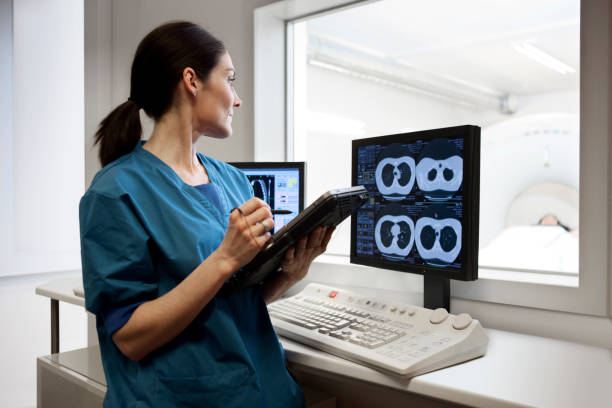How Is Intelligent OCR Useful in Medical Record Scanning

The healthcare industry is one of the largest and most complex industries in the world. Healthcare providers have a tough job because they have to deal with a lot of information and data, like patient records and insurance claims. To make things easier, they use something called OCR, which stands for Optical Character Recognition. It’s like a computer program that can read text from scanned images. This helps healthcare organizations handle all their data in a smarter and faster way.
 How OCR Scanning Works
How OCR Scanning Works
OCR (Optical Character Recognition) scanning works by using technology to convert scanned images or documents into machine-readable text. Here’s a simplified explanation of how OCR scanning works:
-
Capture the Image:
The process starts with capturing an image of a document using a scanner, camera, or other imaging devices. This could be a paper document, a photo, or any text-containing image.
-
Preprocessing:
Before OCR, the scanned image may undergo preprocessing to enhance its quality. This could include tasks like straightening, de-skewing, or adjusting the contrast to improve the accuracy of the OCR process.
-
Text Recognition:
The OCR software analyzes the captured image and identifies patterns that resemble characters. It uses algorithms to recognize the shapes, lines, and curves that form letters and numbers.
-
Character Segmentation:
Once the characters are identified, the software separates them into individual units. This step is crucial for distinguishing one character from another, especially in cases where characters are close together.
-
Feature Extraction:
The OCR system extracts specific features from the characters, such as the shape of letters and the spaces between them. These features help in determining the identity of each character.
-
Text Output:
The recognized characters are then converted into machine-readable text. The OCR software generates an output file that contains the extracted text, which can be edited, searched, or used in various applications.
What is Intelligent Optical Character Recognition?
Intelligent Optical Character Recognition (Intelligent OCR) is an advanced form of OCR (Optical Character Recognition) technology that incorporates artificial intelligence (AI) and machine learning (ML) capabilities. Unlike traditional OCR, Intelligent OCR goes beyond simple character recognition and includes features that enhance the understanding and interpretation of the content being processed. Here are key aspects of Intelligent OCR:
1. Contextual Understanding
Intelligent OCR systems use machine learning algorithms to comprehend the context of the text. This means they can understand not only individual characters but also the relationships between words and the overall meaning of the content.
2. Adaptability and Learning
Intelligent OCR systems can adapt and improve over time. As they process more documents, they learn from the data and enhance their recognition capabilities. This adaptability allows them to handle a variety of document types, layouts, and fonts.
3. Data Extraction and Validation
These systems can automatically extract specific information from documents, such as names, dates, numbers, or other relevant data fields. Additionally, they can validate the extracted data against predefined rules to ensure accuracy.
4. Advanced Character Recognition
Intelligent OCR is capable of accurately recognizing characters even in challenging scenarios, such as distorted images, handwritten text, or documents with complex layouts.
5. Integration With Workflows
Intelligent OCR can be seamlessly integrated into broader business workflows and systems. This integration enables automation of document processing tasks, reducing manual effort and improving overall efficiency.
6. Enhanced Accuracy
The combination of AI and ML in Intelligent OCR leads to higher accuracy in recognizing and interpreting text. This is especially beneficial when dealing with diverse and complex document formats.
What Are the Challenges With Reading a Medical Record?
Reading medical records presents challenges due to varied document formats, including handwritten entries that may be difficult to interpret accurately, especially for optical character recognition (OCR) systems. The specialized medical terminology and abbreviations further complicate automated interpretation, requiring domain expertise. Ensuring patient privacy and data security, in compliance with regulations like HIPAA, adds complexity. Additionally, the dynamic nature of medical information necessitates efficient systems for continuous updates. Healthcare organizations explore advanced technologies like intelligent OCR, machine learning, and natural language processing to address these challenges, aiming to improve accuracy and efficiency while maintaining data security and privacy.
Use Cases of Intelligent OCR for Medical Records Analysis
Intelligent OCR has shown significant promise in various use cases for medical records analysis, bringing efficiency and accuracy to healthcare processes. Here are several use cases where Intelligent OCR proves valuable:
1. Data Extraction and Indexing
Intelligent OCR can automatically extract relevant information from medical records, such as patient demographics, medical history, and treatment details. This streamlines the indexing process, making it easier for healthcare professionals to access critical information quickly.
2. Claim Processing
In the healthcare insurance domain, Intelligent OCR facilitates the extraction of information from medical invoices and claims. This speeds up the processing of insurance claims by automating data entry tasks, reducing errors, and improving overall efficiency in the reimbursement process.
3. Clinical Trial Data Management
Managing and extracting information from vast amounts of clinical trial documents is a complex task. Intelligent OCR assists in automating the extraction of data from clinical trial records, ensuring accurate and timely analysis of trial outcomes and participant information.
4. Adverse Event Reporting
Intelligent OCR helps in the automated extraction of relevant data from medical narratives and adverse event reports. This accelerates the identification and reporting of adverse events, improving patient safety and supporting regulatory compliance.
5. Billing and Coding
Efficient billing and coding processes are crucial for healthcare providers. Intelligent OCR aids in automating the extraction of procedural codes, diagnosis codes, and other billing-related information from medical records, reducing manual effort and minimizing billing errors.
6. Patient Record Summarization
Intelligent OCR contributes to the summarization of patient records by extracting key information such as diagnoses, medications, and treatment plans. This enables healthcare professionals to quickly review and comprehend essential details during patient consultations.
7. Quality Improvement Initiatives
Healthcare organizations use Intelligent OCR to analyze large volumes of medical records for quality improvement initiatives. This includes identifying patterns, trends, and areas for improvement in patient care and outcomes.
8. HIPAA Compliance and Redaction
Intelligent OCR helps in automating the identification and redaction of sensitive patient information to ensure compliance with privacy regulations like HIPAA. This enhances data security and protects patient confidentiality.
Advantages of Utilizing Intelligent OCR
Utilizing Intelligent OCR (Optical Character Recognition) offers several advantages across various industries, including healthcare, finance, legal, and administrative sectors. Here are some key advantages:
-
Increased Efficiency:
Intelligent OCR automates the extraction of text and data from documents, significantly speeding up document processing workflows. This efficiency leads to quicker decision-making and improved overall operational speed.
-
Accuracy Improvement:
With the integration of machine learning and advanced algorithms, Intelligent OCR enhances accuracy in text recognition and data extraction. It can handle complex document structures, various fonts, and even handwritten text, reducing the likelihood of errors compared to traditional OCR systems.
-
Cost Savings:
Automation through Intelligent OCR reduces the need for manual data entry and processing, resulting in cost savings for organizations. The technology allows for the optimization of resources, as human efforts can be redirected to more complex tasks, while routine, repetitive tasks are handled by the OCR system.
-
Enhanced Data Quality:
By automating data extraction and validation, Intelligent OCR contributes to improved data quality. The system can identify and correct errors, ensuring that extracted information is accurate and reliable, which is crucial in data-driven decision-making.
-
Workflow Integration:
Intelligent OCR seamlessly integrates into existing business workflows and systems, facilitating the automation of end-to-end processes. This integration ensures a smooth transition of data between different stages of a workflow, promoting efficiency and reducing manual intervention.
-
Scalability:
Intelligent OCR systems are scalable and can handle large volumes of documents efficiently. As the workload increases, organizations can scale their OCR capabilities to meet growing demands without compromising on performance.
-
Compliance and Security:
In industries with regulatory requirements, such as healthcare and finance, Intelligent OCR helps ensure compliance by automating processes while adhering to privacy and security standards. The technology includes features like redaction to protect sensitive information and maintain confidentiality.
-
Quick Access to Information:
By converting scanned images into machine-readable text, Intelligent OCR enables quick and easy access to information within documents. This is particularly beneficial for tasks like searching and retrieving specific data points from large datasets.
-
Adaptability to Document Variability:
Intelligent OCR systems are designed to adapt to various document formats, layouts, and languages. This adaptability makes them versatile and capable of handling diverse types of documents commonly encountered in different industries.
-
Improved Customer Experience:
In customer-facing processes, Intelligent OCR contributes to faster response times, quicker transaction processing, and improved overall customer experience. It reduces delays associated with manual document handling, leading to increased customer satisfaction.
External Resources
- OCR With Google AI
- Convert Image to Text online
- 22 Best Tools For Graphic Design Professionals
- 5 Best OCR Tools to Convert Images to Text
Final Words
Intelligent OCR revolutionizes document processing by automating tasks, enhancing efficiency, accuracy, and cost-effectiveness. Its adaptability, scalability, and integration capabilities make it invaluable across industries. The technology’s contributions to compliance and data quality enhance its appeal, fostering improved customer experiences and streamlined operations in the digital era. As it evolves, Intelligent OCR continues to shape the future of efficient document management.








